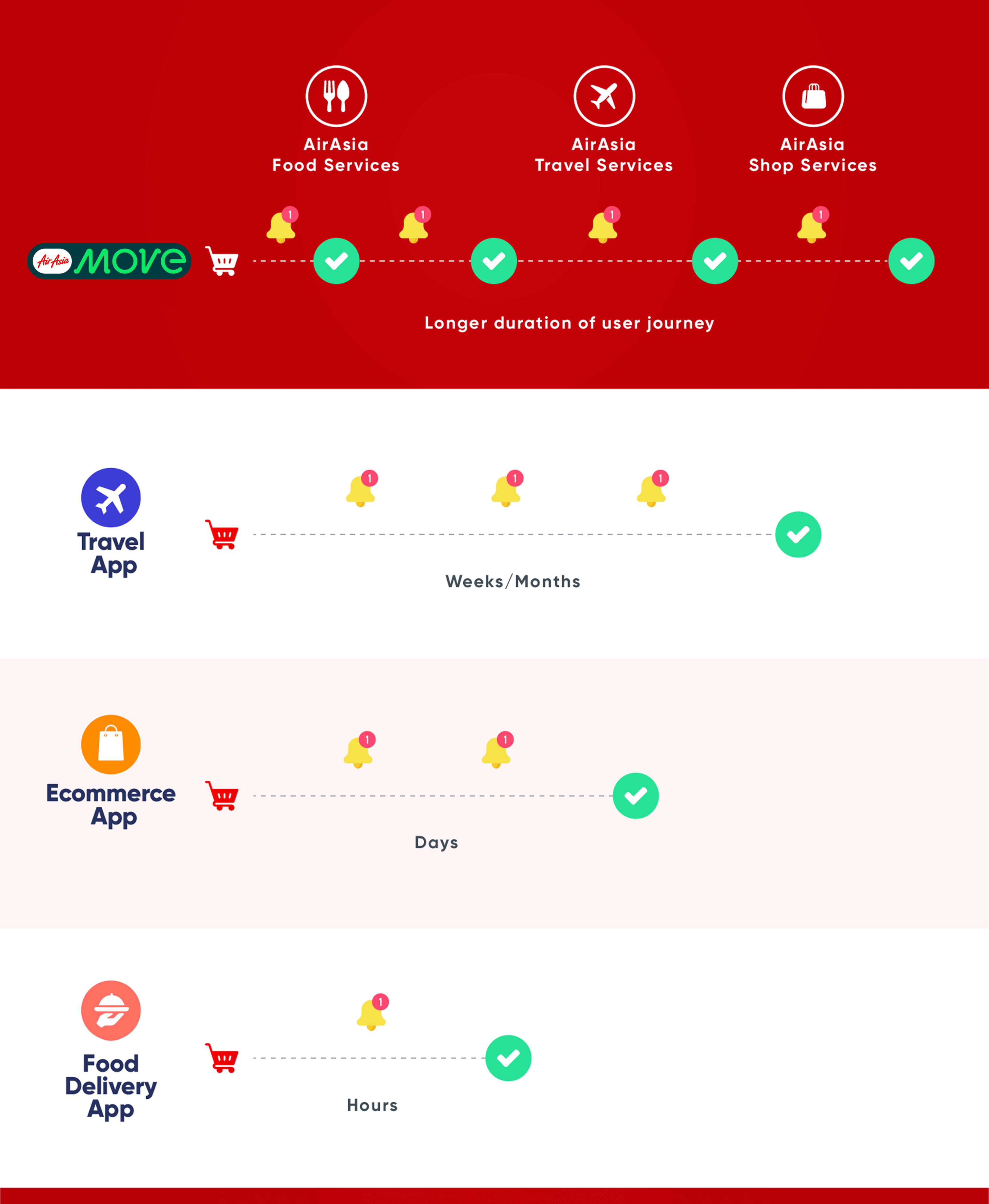While people all over the globe were busy canceling their travel and other plans for 2020 (for reasons we are all-too aware), airasia.com joined the league of ‘super-apps’ in South-East Asia.
Coined by Blackberry founder Mike Lazaridis, the term super-app refers to a platform that offers multiple services under one umbrella. Think Facebook’s WhatsApp, Messenger, and Instagram, or WeChat, which offers messaging, payments, shopping, food delivery, and transportation services. Super-apps offer an integrated and efficient experience to users.
Tony Fernandes, CEO of AirAsia Group said, “We have not wasted the crisis. We’ve been using the lockdown period to finetune our platform, unify the user experience, and simplify our payment to a one-click checkout.”
Under the AirAsia super-app, 15 types of products and services including travel, ecommerce, food delivery, and fintech are available to users. They use this digital ecosystem of over 75 million users and 40 million downloads to generate a personalized and seamless customer experience.
We spoke to a Senior Product Manager, who’s responsible for the social and engagement product modules at AirAsia. During our conversation, we uncovered valuable insights about their evolution into a super-app as well as how they manage marketing automation, engage users, and drive retention.
Virtualization of the Travel Industry
The pandemic has disrupted every industry imaginable. From Airbnb offering online experiences to AirAsia launching their community chatrooms, a lot of things have gone virtual in the travel and hospitality sector.
Witnessing the emergence of COVID-19 in China towards the end of 2019 gave AirAsia Group the heads-up to accelerate their digital transformation plans. It was all about being data-driven, digital, and diversified. Their business-as-usual was drastically impacted by the pandemic, which was the impetus for them to focus aggressively on becoming the comprehensive lifestyle platform they are today.
Their original digital transformation plans went through some iterations to make them more relevant to the COVID-stricken world. They launched AirAsia Unlimited Pass, which enables pass holders to take unlimited flights for a year. This initiative was later replicated across geographies. Seeing the emerging need for affordable travel and stay options, they launched SNAP, offering discounted prices on flight and hotel combinations.
They also observed increasing demand from customers for things like home delivery of food and duty-free items. By redirecting their focus on these services, they were able to increase their customer engagement and retention.
Starting Point: Choosing a Marketing Automation Partner
Consumers expect brands to anticipate their evolving needs, address those needs with timely communications, and forge genuine connections. As a result, brands are increasingly focused on creating consistent brand experiences across touchpoints.
While upgrading to a super-app, AirAsia started building a social infrastructure within the app to drive community features and create a sense of shared community among like-minded travelers. The greater goal is to make every user feel special.
Marketing automation was new to AirAsia. One of their key goals was to activate various messaging channels such as push notifications, in-app messages, app inbox, and web notifications in order to enhance user engagement and keep users connected. Personalization was another key area that had the potential to change the engagement game for AirAsia.
While user acquisition and engagement were important, another priority for Valecha was working with his marketing team to build a holistic user journey to drive both growth and user retention.
By choosing CleverTap as their marketing automation partner, AirAsia is able to easily create and optimize omnichannel campaigns. This allows them to draw users into deeper levels of engagement with their app and brand—and do so in a systematic way.
User Journey: Ecommerce vs. AirAsia App
In an ecommerce app, the user journey from order placement to delivery takes about one week; in food delivery, users complete that journey within hours. This means the time available for marketers to engage users is relatively short. Users want their orders fulfilled as soon as possible, and afterward users generally don’t need or want further engagement. At this point, engagement efforts become more promotional than transactional and may drive users away.
Travel apps, on the other hand, offer a longer window of time for marketers to engage users regarding an upcoming journey. Knowing the travel details also helps. Be it time-sensitive messages about check-in status or hotel availability, there is increased opportunity to send the kind of transactional messages that users expect from a travel app.

Offering services in multiple categories like food delivery, ecommerce, fintech, and travel have made the user journey for AirAsia different from a typical delivery or ecommerce app. This difference is reflected in their north star metrics as well.
For an ecommerce or food delivery app, DAU (daily active users) is usually an essential metric, but at AirAsia, it’s MAU (monthly active users) that matter. With cohorts, they can view user retention based on the larger range of transactions.
Since AirAsia provides over 15 products and services across multiple verticals, they also track the number of categories in which a user transacts. Some other key metrics include app launches, week 1 registrations and transactions, stickiness, and unique transacting users.
Becoming the Center of Conversation
Connecting people to people, fostering a sense of community, and conversing directly with users are important components of AirAsia’s engagement strategy. As a part of their digital transformation, they built a chat function in their app which is used by nearly one million users monthly. Post lockdown, multiple chat rooms in the app were buzzing with conversations about safety and restrictions across various destinations in South Asia.

AirAsia engages with active users with in-app messages and app inbox, and brings inactive users back to the app with push notifications. Using CleverTap’s action based push, they drive contextual communications, resulting in higher conversions.
Users receive a push notification instantly when they perform an action in the app, instead of at the next app launch. For example, if a user drops off while searching for a flight, they receive a push notification with an image prompting them to return, resulting in a 12% boost in conversions.
AirAsia has a significant user base in China, where Chinese OEM dominates the smartphone market. These devices don’t use Google Play Services and have a poor delivery rate for push notifications—often as low as 10%. Using CleverTap’s Xiaomi and Huawei Push Service Support and Baidu Push, AirAsia is able to reach more users.
By orchestrating their campaigns on CleverTap, AirAsia has seen a boost of 1.86% and 1.23% on their sticky quotient and repeat transaction behavior, respectively. Overall, their retention rates are 9.1% higher than the industry average. And, they’ve managed to lower their average uninstall rate (within 30 days of first app launch) by an impressive 80%.
The Road Ahead
AirAsia’s inspiration for becoming a super-app was to create more use cases within the app. Having multiple products and services under a single ecosystem has increased repeat visits and expanded their understanding of user behavior. Their next step is to add more ecommerce and grocery products to their platform.
Apart from the existing messaging channels, AirAsia intends to integrate their emails with CleverTap and start using native display. And of course, they plan to continue to roll out features that help them to further engage their user community.
Mrinal Parekh 
Leads Product Marketing & Analyst Relations.Expert in cross-channel marketing strategies & platforms.
Free Customer Engagement Guides
Join our newsletter for actionable tips and proven strategies to grow your business and engage your customers.















































